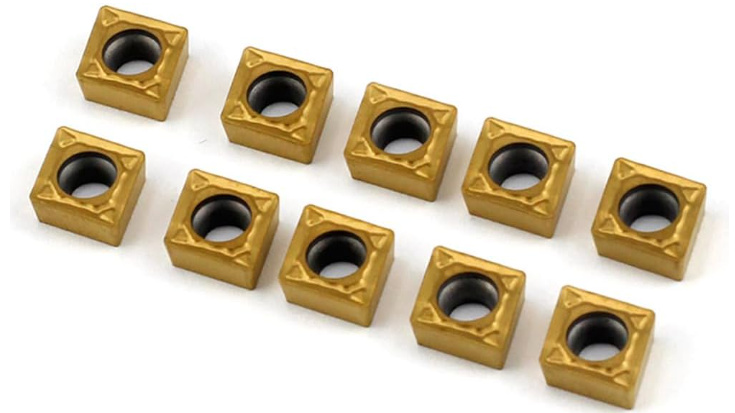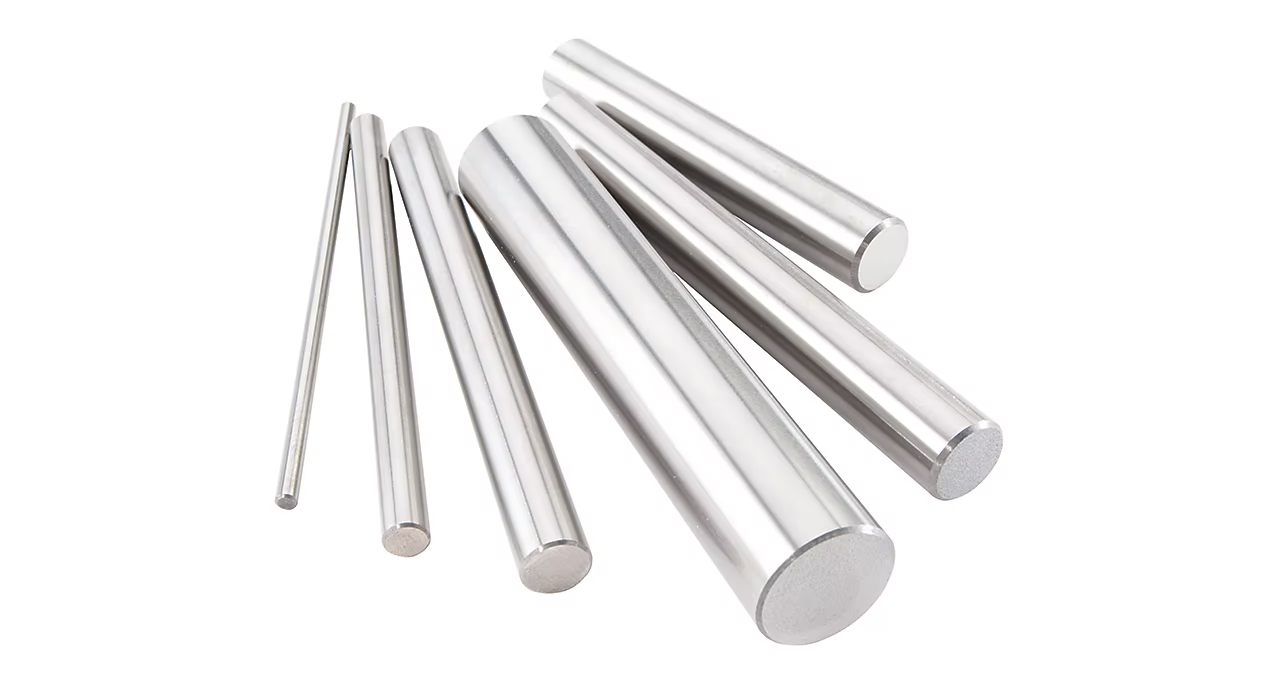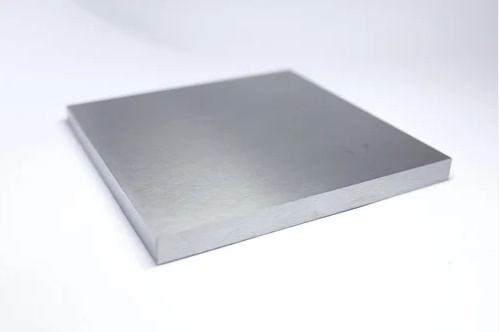Dans le monde de l'usinage, où la précision et l'efficacité règnent en maître, le choix du bon matériau pour les outils de coupe peut faire toute la différence. Bien qu'il existe plusieurs options, carbure inserts se sont imposés comme les champions incontestés, révolutionnant les processus d'usinage dans d'innombrables industries.
Mais qu'est-ce qui rend les plaquettes en carbure supérieures aux autres matériaux d'outils de coupe ? Cet article de blog se penche sur les 7 avantages indéniables qui ont propulsé les plaquettes en carbure au premier plan de la fabrication moderne.

1. Dureté inégalée : À la conquête des matériaux les plus durs
Les plaquettes en carbure, principalement composées de carbure de tungstène, présentent une dureté exceptionnelle, nettement supérieure à celle des aciers à outils traditionnels et des aciers rapides (HSS). Cette dureté remarquable permet aux plaquettes en carbure d'usiner sans effort une large gamme de matériaux, notamment :
- Aciers trempés : Les plaquettes en carbure peuvent s'attaquer à des aciers trempés qui s'émousseraient ou s'abîmeraient rapidement avec des outils en acier rapide, ce qui élargit les possibilités d'usinage et permet de créer des composants plus durables.
- Alliages exotiques : L'aérospatiale et d'autres industries à hautes performances font appel à des alliages exotiques présentant des rapports poids/résistance exceptionnels. Les plaquettes en carbure excellent dans l'usinage de ces matériaux difficiles, contribuant aux progrès dans l'aérospatiale, la médecine et d'autres domaines exigeants.
- Matériaux abrasifs : Les matériaux tels que la fonte, la fibre de verre et les composites à base de fibre de carbone, connus pour leurs propriétés abrasives, peuvent rapidement user les outils de coupe traditionnels. Les plaquettes en carbure, grâce à leur dureté supérieure, résistent à l'usure et conservent leur arête de coupe pendant de longues périodes, même lors de l'usinage de ces matériaux abrasifs.
2. Résistance exceptionnelle à l'usure : Minimiser les temps d'arrêt, maximiser la productivité
L'un des principaux avantages des plaquettes en carbure réside dans leur résistance exceptionnelle à l'usure. Comparées à d'autres matériaux d'outils de coupe, les plaquettes en carbure conservent leurs arêtes de coupe vives pendant des périodes beaucoup plus longues. Cela se traduit par :
- Réduction des changements d'outils : Moins de changements d'outils signifie moins de temps d'arrêt et une utilisation accrue des machines, ce qui a un impact direct sur la productivité et la rentabilité.
- Réduction des coûts d'outillage : Bien que les plaquettes en carbure puissent avoir un coût initial plus élevé, leur durée de vie prolongée permet souvent de réduire les dépenses globales d'outillage au fil du temps.
- Amélioration de la cohérence des pièces : L'usure régulière de l'outil garantit une plus grande précision dimensionnelle et une meilleure homogénéité de l'état de surface tout au long des cycles de production, ce qui réduit les taux de rebut et améliore la qualité globale des pièces.
3. L'usinage à grande vitesse : Accélérer la production, améliorer l'efficacité
Les plaquettes en carbure sont conçues pour résister aux températures et aux forces extrêmes générées lors des opérations d'usinage à grande vitesse. Cela permet :
- Augmentation de la vitesse de coupe : Les plaquettes en carbure peuvent fonctionner à des vitesses de coupe nettement plus élevées que les outils en acier rapide, ce qui permet de réduire considérablement les temps d'usinage et d'augmenter le rendement de la production.
- Amélioration des finitions de surface : Des vitesses de coupe plus élevées, combinées aux propriétés inhérentes des plaquettes en carbure, permettent souvent d'obtenir des finitions de surface plus lisses, réduisant ou éliminant la nécessité d'opérations de finition secondaires.
- Contrôle amélioré des puces : Les plaquettes en carbure, avec leurs arêtes de coupe tranchantes et leurs géométries optimisées, favorisent la formation et l'évacuation efficaces des copeaux, ce qui est essentiel pour maintenir des performances de coupe constantes et éviter l'accumulation de copeaux qui peuvent endommager la pièce à usiner ou l'outil.
4. Polyvalence d'application : Un outil pour chaque tâche
Les plaquettes en carbure sont incroyablement polyvalentes et sont disponibles dans une vaste gamme de nuances, de géométries et de revêtements adaptés à des opérations d'usinage et à des matériaux spécifiques. Cette gamme étendue d'options garantit qu'il existe une plaquette en carbure parfaitement adaptée à pratiquement toutes les tâches d'usinage, y compris.. :
- Tournant : De l'ébauche à la finition, les plaquettes en carbure excellent dans le tournage des diamètres extérieurs et intérieurs, la création de rainures et le tronçonnage des pièces.
- Fraisage : Les plaquettes en carbure sont largement utilisées dans les applications de fraisage, enlevant efficacement la matière dans les opérations de surfaçage, d'épaulement et de rainurage.
- Forage : Les forets à pointe en carbure offrent des performances supérieures dans les applications de perçage, en particulier lors du perçage de matériaux durs ou de trous de haute précision.
- Ennuyeux : Les plaquettes en carbure sont également utilisées dans les outils d'alésage, ce qui permet de créer des diamètres internes précis et des finitions d'alésage lisses.
5. Précision et exactitude accrues : Répondre aux demandes de tolérances serrées
La fabrication moderne exige souvent des tolérances extrêmement serrées, en particulier dans les secteurs de l'aérospatiale, de la médecine et de l'électronique. Les plaquettes en carbure, grâce à leur capacité à maintenir des arêtes de coupe vives et à résister à la déformation sous des forces de coupe élevées, répondent parfaitement à ces exigences rigoureuses :
- Géométries complexes : Les plaquettes en carbure peuvent produire des formes et des caractéristiques complexes avec une précision exceptionnelle, ce qui est essentiel pour les composants dont la conception est complexe ou dont les exigences en matière de tolérance sont très strictes.
- Réduction des vibrations : La rigidité inhérente de la plaquette en carbure minimise les vibrations pendant l'usinage, ce qui contribue à améliorer les états de surface et la précision dimensionnelle.
- Finitions de surface fines : Les plaquettes en carbure permettent d'obtenir des finitions de surface extrêmement fines, éliminant souvent le besoin d'opérations de finition secondaires telles que le meulage ou le polissage.
6. Le rapport coût-efficacité à long terme : Maximiser le retour sur investissement
Bien que les plaquettes en carbure puissent avoir un coût initial plus élevé que certains matériaux d'outils traditionnels, leur rentabilité à long terme est indéniable.
Tenez compte des facteurs suivants :
- Durée de vie prolongée de l'outil : Les plaquettes en carbure durent beaucoup plus longtemps que les outils en acier rapide, ce qui réduit la fréquence des remplacements d'outils et les coûts globaux d'outillage.
- Augmentation de la productivité : Des vitesses de coupe plus élevées et des temps d'arrêt réduits pour les changements d'outils se traduisent par une augmentation de la production, maximisant ainsi le retour sur investissement.
- Amélioration de la qualité des pièces : L'usure régulière de l'outil et l'amélioration de la précision se traduisent par des pièces de meilleure qualité, ce qui réduit les taux de rebut et minimise la perte de matière.
7. Compatibilité avec les technologies d'usinage avancées
Les plaquettes en carbure sont compatibles avec une large gamme de technologies d'usinage avancées, ce qui améliore encore leurs capacités et élargit leurs applications :
- Usinage CNC : Les plaquettes en carbure conviennent parfaitement aux centres d'usinage à commande numérique (CNC), où la précision et la répétabilité sont primordiales.
- Systèmes de refroidissement à haute pression : L'utilisation de systèmes d'arrosage à haute pression avec des plaquettes en carbure optimise l'évacuation des copeaux, améliore la dissipation de la chaleur et prolonge la durée de vie de l'outil, en particulier dans les opérations d'usinage exigeantes.
- Usinage à sec : Certaines qualités de plaquettes en carbure sont spécialement conçues pour les applications d'usinage à sec, ce qui élimine le besoin de fluides de coupe et favorise les processus de fabrication respectueux de l'environnement.
Plaquettes en carbure et autres matériaux pour outils de coupe : Un aperçu comparatif
| Matériau | Dureté | Résistance à l'usure | Vitesse de coupe | Coût | Avantages | Inconvénients |
|---|---|---|---|---|---|---|
| Insert en carbure | Extrêmement élevé | Excellent | Haut | Haut | Dureté exceptionnelle, résistance à l'usure, capacité de production à grande vitesse, polyvalence, précision | Coût initial plus élevé |
| Acier rapide (HSS) | Haut | Bon | Modéré | Modéré | Bon équilibre général des propriétés, adapté à une large gamme de matériaux | Dureté et résistance à l'usure inférieures à celles des plaquettes en carbure |
| Acier au cobalt | Très élevé | Très bon | Modéré | Haut | Excellente résistance à la chaleur, convient aux applications à haute température | Plus cher que l'acier rapide, dureté inférieure à celle de la plaquette en carbure |
| Céramique | Extrêmement élevé | Excellent | Très élevé | Très élevé | Dureté exceptionnelle, résistance à l'usure et capacité de production à grande vitesse, adaptée aux matériaux très durs. | Fragile, susceptible de s'ébrécher ou de se briser |
Conclusion : Adopter l'avantage du carbure
Les avantages des plaquettes en carbure par rapport aux autres matériaux d'outils de coupe sont indéniables. Leur dureté exceptionnelle, leur résistance à l'usure, leur capacité à travailler à grande vitesse, leur polyvalence et leur précision ont révolutionné les processus d'usinage, permettant la création de produits de meilleure qualité, plus complexes et plus abordables dans une multitude d'industries.
Alors que la technologie continue de progresser et que les exigences de fabrication deviennent de plus en plus strictes, les plaquettes en carbure resteront sans aucun doute à l'avant-garde de la technologie des outils de coupe, stimulant l'innovation et façonnant l'avenir de la fabrication.
Vous souhaitez acheter une plaquette en carbure de grande qualité au meilleur prix ? Cliquez ici ici.




